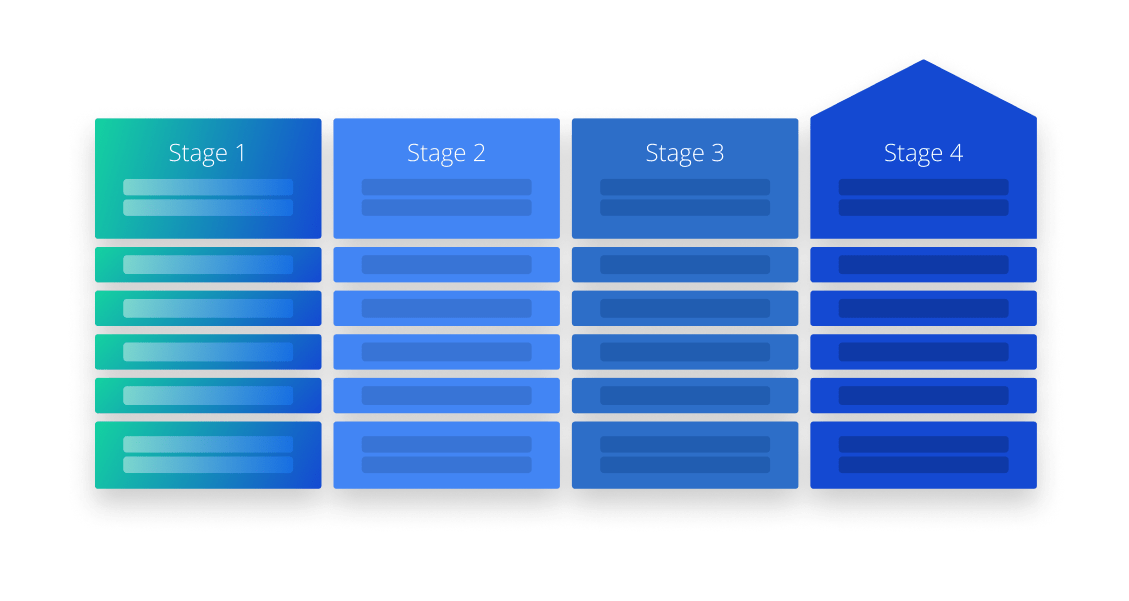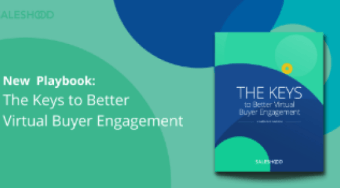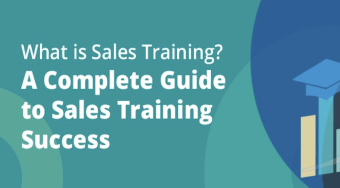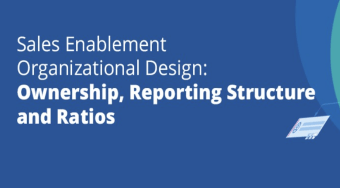In today’s competitive sales landscape, the concept of revenue enablement has evolved from a nice-to-have to a critical component of a company’s growth strategy. Modern revenue enablement extends beyond traditional sales enablement to cover a wide range of roles, including Account Executives (AEs), Sales Development Representatives (SDRs), Sales Consultants (SCs), Customer Success Managers (CSMs), and even partners. To guide organizations through this complex process, SalesHood developed a Revenue Enablement Maturity Model based on decades of working with high performing companies and revenue teams. This model provides a structured path from foundational to transformative enablement, providing organizations a proven path to meet their revenue targets through a well-defined and repeatable process.
The SalesHood Revenue Enablement Maturity Model is broken down into four stages, each building on the previous one. In this post, we’ll dive into each stage, exploring the processes and outcomes at each level, and how this model can serve as a roadmap for organizations aiming to maximize revenue impact.
References to industry research by Gartner and Forrester highlight the pressing need for revenue enablement in achieving scalable growth.

Stage 1: Foundational Enablement
At the foundation of the model, organizations establish the essential skills and knowledge required for revenue generation. Foundational Enablement focuses on basic training and core resources that help revenue teams get up to speed quickly.
- Product & Skills Training: Companies boost competency and confidence by equipping team members with product knowledge and core selling skills. It’s the starting point for any enablement journey, providing a solid base to understand what the company offers and how to communicate value to prospects effectively.
- Onboarding: Structured onboarding programs shorten the time to productivity for new hires. According to Forrester and many SalesHood customers, effective onboarding reduces ramp time and allows new team members to contribute to revenue generation more quickly.
- Sales Content Library: Having a centralized content library is crucial in the foundational stage. Reps quickly access sales decks, case studies, and other assets they need to engage with buyers without wasting time on content searches. Salespeople need to be able to spend less time searching and more time selling.
- Sales Methodology: Establishing a standardized sales methodology is key for consistency. Whether it’s MEDDICC, Challenger, or another method, a formalized approach ensures everyone speaks the same language and approaches sales with the same mindset.
Outcomes: At this stage, the main outcomes include completion of foundational training, reduced ramp time for new hires, and improved time-to-productivity. Organizations in this phase are building the groundwork for a scalable revenue model but still lack advanced enablement processes and tools.
Stage 2: Just-In-Time Enablement
Once foundational capabilities are in place, the next step is to deliver timely and role-specific resources that enable team members to perform at a higher level. Just-In-Time Enablement focuses on adapting content and coaching to meet immediate needs.
- Role-Based Training: Tailored training modules designed for different roles (AEs, SDRs, SCs, etc.) enable each team to access resources that are directly relevant to their responsibilities, optimizing their impact.
- Manager & AI Coaching: With the advent of AI, real-time coaching is possible, allowing managers to guide team members based on data insights. According to Gartner, AI-enabled coaching can significantly increase engagement and skill development by delivering personalized feedback. Many SalesHood customers, both reps and managers, are realizing efficiency boosts with GenAI.
- Buyer’s Journey Content: As prospects move through different stages of the buyer’s journey, they require relevant information. This stage ensures that content is aligned with the buyer’s needs, allowing sales to provide the right resources at the right time.
- Plays & Guided Selling: Playbooks and guided selling paths provide actionable steps for different scenarios, such as objection handling or upselling. Reps can refer to these guides to execute specific plays in real-time.
Outcomes: At this stage, companies begin to see improvements in pipeline progression and quota attainment. With content and coaching delivered just-in-time, revenue teams are better equipped to drive prospects toward closing, thus accelerating the sales cycle.
Stage 3: Optimized Enablement
As organizations mature, they reach a point where they can leverage advanced technologies and frameworks to create an optimized, highly efficient enablement ecosystem. Optimized Enablement introduces a layer of automation, peer-to-peer learning, and in-depth analytics.
- Certification Programs: Formal certification programs validate the knowledge and skills of team members, ensuring they meet performance standards. Certified reps are often more confident and effective in customer interactions, directly contributing to higher close rates.
- Peer-to-Peer Learning: Creating an environment where team members can learn from each other’s experiences fosters a culture of continuous improvement. Peer insights can help less experienced reps gain valuable skills and techniques from top performers.
- Automated AI Content: AI helps distribute assets based on content used in winning deals and top performers best practices. For instance, if a rep is working on a specific deal (industry, segment, persona, objection etc) AI would suggest relevant content or practice scenarios.
- Digital Sales Rooms: Digital Sales Rooms (DSRs) offer a collaborative space where sales teams and buyers can interact, share resources, and track engagement. According to Forrester, companies using DSRs report better alignment with buyers and increased deal velocity.
Outcomes: In this optimized stage, companies see improved content insights, win rates, and shorter sales cycles. Automation and data-driven approaches make it easier to identify effective content and remove bottlenecks in the sales process.
Stage 4: Transformative Enablement
The pinnacle of the Revenue Enablement Maturity Model is Transformative Enablement, where organizations leverage 1:1 personalization, predictive tools, and advanced forecasting insights. This stage represents a fully evolved enablement strategy that focuses on empowering individual contributors with precision.
- 1:1 AI Training: Personalized training ensures that each team member receives AI guidance tailored to their unique skills and needs. By addressing specific areas for improvement, 1:1 training maximizes the potential of each team member.
- Personalized AI Coaching: Using advanced analytics, managers are empowered with data to provide bespoke coaching recommendations based on an individual’s performance and engagement metrics. AI plays a big role in organizing highly personalized and relevant feedback to each individual at scale.
- AI Content Creation: Based on scenarios and buyer engagement, GenAI uses past deal and existing content buyer engagement data to create new assets including videos, slide presentations and business cases. The content is 100% tailored and branded to a specific business’s needs.
- Forecasting Insights: Accurate forecasting insights enable leaders to predict revenue outcomes based on content consumption, buyer engagement and deal progression. These insights come together in tight data integrations between revenue enablement and revenue operations.
Outcomes: Transformative Enablement yields targeted revenue metrics on an individual level, fostering significant improvements in quota attainment and customer satisfaction. By fully personalizing the enablement experience, organizations reach peak efficiency, supporting a culture of continuous improvement and innovation.
Why Revenue Enablement Matters
The progression through these stages reflects a broader trend in the sales industry: the shift from reactive to proactive enablement. Gartner and Forrester research indicates that sales teams empowered with real-time insights, role-specific resources, and AI-powered coaching outperform their peers. As revenue enablement becomes more sophisticated, companies are seeing improved alignment across revenue teams, faster onboarding, and increased deal success.
SalesHood’s Revenue Enablement Maturity Model provides a clear roadmap for organizations looking to unlock the potential of their revenue teams. Starting with foundational skills and scaling up to personalized, predictive enablement, the model is designed to evolve with the needs of an organization as it grows. By following this roadmap, companies can create a cohesive, high-performing revenue team ready to meet the demands of today’s buyers and drive consistent growth.
In conclusion, adopting a structured, maturity-based approach to revenue enablement ensures that sales organizations are not just meeting current needs but also building a foundation for long-term success. With SalesHood’s model, companies have the guidance they need to progress from foundational skills to transformative outcomes, aligning all revenue-generating roles toward a common goal: sustainable revenue growth.



